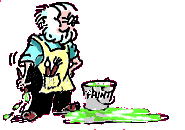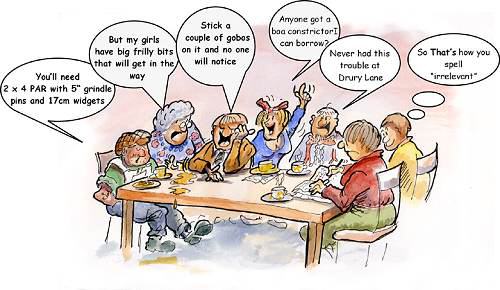Extracts from.....PAINTING SCENERY FOR THE AMATEUR STAGE By Brian Willis

CHAPTER ONE
MEETINGS AND THE HALL
First of all get hold of a copy of the script and read it.
What are the scenes? Are they happy or sad? Any ideas that sing out at you from the story?
Could you have scenes of contrasting hues or tones following each other? The dark dank miserable cool neutral greys and blues of a prison cell of Nottingham Castle followed by the light and spring-like greens of a Sherwood Forest Glade.
What is the time of year when the action place?
In what era does the play take place? Perhaps there's some research to be done; photos to be dug out of the library; Travel Brochures to be sent for (Pity the poor old White Horse Inn on the shores of Lake Wolfgang in Northern Austria!)
MEETING THE PRODUCTION TEAM

Now you know what the play is about, the next move is to attend production meetings where ideally the following are present .....Producer; Set designer (if that's not you): Set builder: Costumes: Lighting: Props: Stage Manager; Production Manager;
Take a sketchpad; the script; a notebook and your diary.
With everyone joining in, it saves you a lot of phone calls to recheck things later.- nevertheless note down all their phone numbers.
Compromise is the word that springs to mind during these meetings!
From these gatherings you need to know...............
BUILDING CONTACT
Who is in charge of building the scenery? Quite often in amateur circles where
everyone mucks in, the scenery is made by a gang resulting in different people
going off
at a tangent. This becomes a shambles unless one person is the figurehead (and
even
that sometimes leads to dissension in the ranks) But you, as the scenic artist,
need to
have one main contact through which to work.
What is each scene to depict and in what order? (Yes I know you've read the script
but the Producer may have altered, added, dropped, things)
Where does the interval fit in this list?